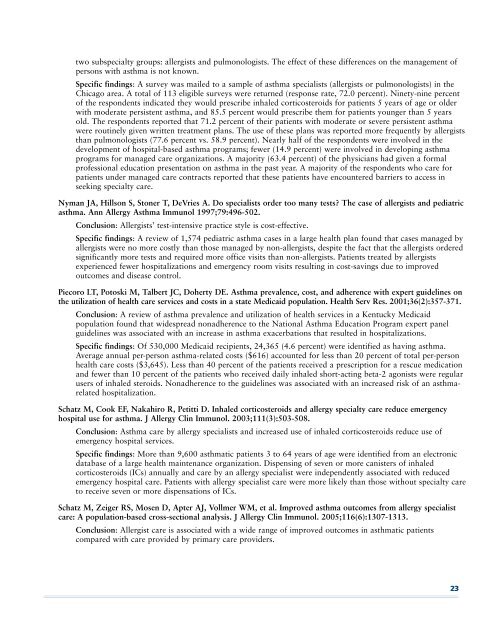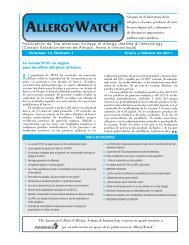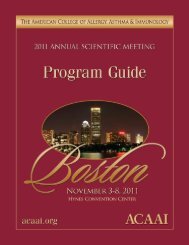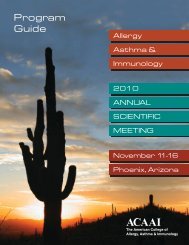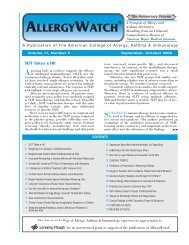Better Outcomes at Lower Cost - American College of Allergy ...
Better Outcomes at Lower Cost - American College of Allergy ...
Better Outcomes at Lower Cost - American College of Allergy ...
- No tags were found...
You also want an ePaper? Increase the reach of your titles
YUMPU automatically turns print PDFs into web optimized ePapers that Google loves.
two subspecialty groups: allergists and pulmonologists. The effect <strong>of</strong> these differences on the management <strong>of</strong>persons with asthma is not known.Specific findings: A survey was mailed to a sample <strong>of</strong> asthma specialists (allergists or pulmonologists) in theChicago area. A total <strong>of</strong> 113 eligible surveys were returned (response r<strong>at</strong>e, 72.0 percent). Ninety-nine percent<strong>of</strong> the respondents indic<strong>at</strong>ed they would prescribe inhaled corticosteroids for p<strong>at</strong>ients 5 years <strong>of</strong> age or olderwith moder<strong>at</strong>e persistent asthma, and 85.5 percent would prescribe them for p<strong>at</strong>ients younger than 5 yearsold. The respondents reported th<strong>at</strong> 71.2 percent <strong>of</strong> their p<strong>at</strong>ients with moder<strong>at</strong>e or severe persistent asthmawere routinely given written tre<strong>at</strong>ment plans. The use <strong>of</strong> these plans was reported more frequently by allergiststhan pulmonologists (77.6 percent vs. 58.9 percent). Nearly half <strong>of</strong> the respondents were involved in thedevelopment <strong>of</strong> hospital-based asthma programs; fewer (14.9 percent) were involved in developing asthmaprograms for managed care organiz<strong>at</strong>ions. A majority (63.4 percent) <strong>of</strong> the physicians had given a formalpr<strong>of</strong>essional educ<strong>at</strong>ion present<strong>at</strong>ion on asthma in the past year. A majority <strong>of</strong> the respondents who care forp<strong>at</strong>ients under managed care contracts reported th<strong>at</strong> these p<strong>at</strong>ients have encountered barriers to access inseeking specialty care.Nyman JA, Hillson S, Stoner T, DeVries A. Do specialists order too many tests? The case <strong>of</strong> allergists and pedi<strong>at</strong>ricasthma. Ann <strong>Allergy</strong> Asthma Immunol 1997;79:496-502.Conclusion: Allergists’ test-intensive practice style is cost-effective.Specific findings: A review <strong>of</strong> 1,574 pedi<strong>at</strong>ric asthma cases in a large health plan found th<strong>at</strong> cases managed byallergists were no more costly than those managed by non-allergists, despite the fact th<strong>at</strong> the allergists orderedsignificantly more tests and required more <strong>of</strong>fice visits than non-allergists. P<strong>at</strong>ients tre<strong>at</strong>ed by allergistsexperienced fewer hospitaliz<strong>at</strong>ions and emergency room visits resulting in cost-savings due to improvedoutcomes and disease control.Piecoro LT, Potoski M, Talbert JC, Doherty DE. Asthma prevalence, cost, and adherence with expert guidelines onthe utiliz<strong>at</strong>ion <strong>of</strong> health care services and costs in a st<strong>at</strong>e Medicaid popul<strong>at</strong>ion. Health Serv Res. 2001;36(2):357-371.Conclusion: A review <strong>of</strong> asthma prevalence and utiliz<strong>at</strong>ion <strong>of</strong> health services in a Kentucky Medicaidpopul<strong>at</strong>ion found th<strong>at</strong> widespread nonadherence to the N<strong>at</strong>ional Asthma Educ<strong>at</strong>ion Program expert panelguidelines was associ<strong>at</strong>ed with an increase in asthma exacerb<strong>at</strong>ions th<strong>at</strong> resulted in hospitaliz<strong>at</strong>ions.Specific findings: Of 530,000 Medicaid recipients, 24,365 (4.6 percent) were identified as having asthma.Average annual per-person asthma-rel<strong>at</strong>ed costs ($616) accounted for less than 20 percent <strong>of</strong> total per-personhealth care costs ($3,645). Less than 40 percent <strong>of</strong> the p<strong>at</strong>ients received a prescription for a rescue medic<strong>at</strong>ionand fewer than 10 percent <strong>of</strong> the p<strong>at</strong>ients who received daily inhaled short-acting beta-2 agonists were regularusers <strong>of</strong> inhaled steroids. Nonadherence to the guidelines was associ<strong>at</strong>ed with an increased risk <strong>of</strong> an asthmarel<strong>at</strong>edhospitaliz<strong>at</strong>ion.Sch<strong>at</strong>z M, Cook EF, Nakahiro R, Petitti D. Inhaled corticosteroids and allergy specialty care reduce emergencyhospital use for asthma. J <strong>Allergy</strong> Clin Immunol. 2003;111(3):503-508.Conclusion: Asthma care by allergy specialists and increased use <strong>of</strong> inhaled corticosteroids reduce use <strong>of</strong>emergency hospital services.Specific findings: More than 9,600 asthm<strong>at</strong>ic p<strong>at</strong>ients 3 to 64 years <strong>of</strong> age were identified from an electronicd<strong>at</strong>abase <strong>of</strong> a large health maintenance organiz<strong>at</strong>ion. Dispensing <strong>of</strong> seven or more canisters <strong>of</strong> inhaledcorticosteroids (ICs) annually and care by an allergy specialist were independently associ<strong>at</strong>ed with reducedemergency hospital care. P<strong>at</strong>ients with allergy specialist care were more likely than those without specialty careto receive seven or more dispens<strong>at</strong>ions <strong>of</strong> ICs.Sch<strong>at</strong>z M, Zeiger RS, Mosen D, Apter AJ, Vollmer WM, et al. Improved asthma outcomes from allergy specialistcare: A popul<strong>at</strong>ion-based cross-sectional analysis. J <strong>Allergy</strong> Clin Immunol. 2005;116(6):1307-1313.Conclusion: Allergist care is associ<strong>at</strong>ed with a wide range <strong>of</strong> improved outcomes in asthm<strong>at</strong>ic p<strong>at</strong>ientscompared with care provided by primary care providers.23


